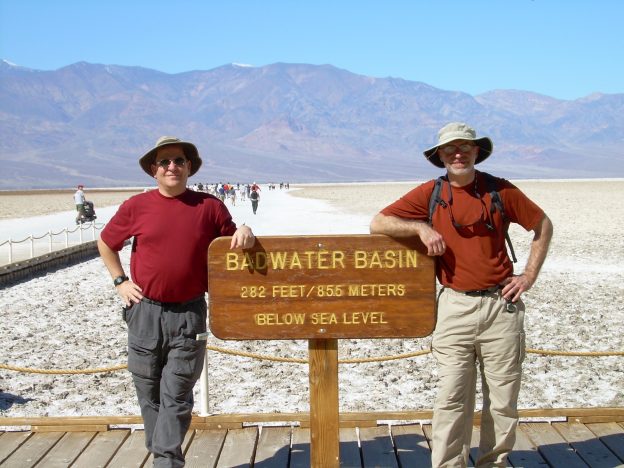Death Valley CA is an interesting place. A place with a dry, forbidding and hostile environment but when one ventures off into one of the myriad of canyons one experiences the tremendous and beautiful power of flash floods. Slick canyon walls that have been carved out over the years are just jaw dropping in beauty. And speaking of beauty, the wild flowers were in abundance during this trip.
Backpackers: Ed Tucker and Carl Fisher
The first day (March 08, 2008) we ventured into Natural Bridge Canyon on a ranger lead hike. The ranger was very informative and gave us a lot of history of the area. The attraction of this canyon is the arches that have been carved over the years. After the hike we continued on down the road Badwater: the lowest place in the western hemisphere, the driest in the nation, and, quite probably, the hottest spot on Earth. Our trip was in March so it was only in the 70’s so it was a comfortable walk as we found, I think, the second lowest spot on the Earth. Water pools here and then evaporates leaving behind salt deposits that create interesting patterns.
On our return from Badwater we stopped and took a photo hike, lead by a park volunteer, into Golden Canyon up to Red Cathedral. While in the Golden Canyon the wind started kicking up and when we arrived back at camp where our tents were pitched. The person on the site next to ours was our guardian angel and had come over when it became apparent that Ed’s tent was about to be blown away and put large rocks on the tent to hold it in place. Carl’s tent held its own but still needed additional rocks to hold it in place and Ed’s needed a car.
On our second day (March 09, 2008) we again went on a ranger lead hike to Monarch Canyon which led to Monarch Spring. The spring ends with a 110 foot waterfall that goes underground after another 100 feet. On the approach to the canyon the desert floor is littered with rusted, metal remnants of the by-gone era of gold mining. Afterwards we drove to Scotty’s Castle where we did the castle and underground tours – both of which were not real impressive. The story behind Scotty and the castle makes for interesting reading.
I think the hike up Titus Canyon to the ghost town of Leadfield on March 10, 2008 was my favorite day of the trip. It was an 8.1 mile hike up the canyon which was wide enough for several 4 wheel vehicles to pass. About 6 miles into the canyon there are petroglyphs, Native American drawings on rocks. They are not very impressive. Leadfield, on the other hand, was well worth the walk. There is an abandoned mine and several building which were interesting to explore.

The next day (March 11, 2008) found us hiking Mosiac Canyon in the morning and then exploring the sand dunes. We stayed at the Furnace Creek campground and had two bottles of wine after dinner.
Today (March 12, 2008) was the most physically demanding. We decided to backpack eight or nine miles up Indian Pass Canyon to an area that had reliable water. Navigating in the desert is much tougher than we had expected, even though we both have military training in land navigation. We finally found the right canyon hiking an unnecessary additional 3 miles. At this point it was getting to be 3pm and we decided it wasn’t worth going forward so we turned around and headed for the car and another night of drinking wine. We also found numerous Desert Five Spot wildflowers.

We took another ranger lead hike today (March 13, 2008) at the abandoned Keane Wonder Mine, the most productive gold mine in Death Valley. The ore was mined high up in the mountains and then brought down to the mill via a cable car system, similar to a ski lift. Water was piped from the mountain top to the mill to a water tank where it was then used in the process to get the gold.
We had planned to do several days of backpacking during this week and only did one due to the lack of water. However, it was very interesting exploring all of the diverse ecology of Death Valley.

